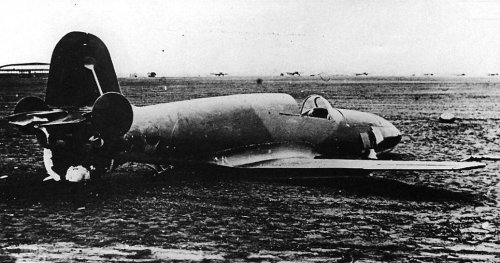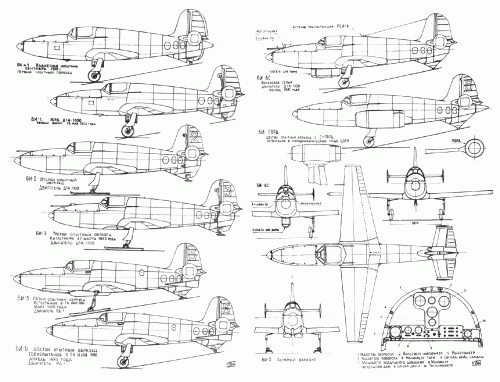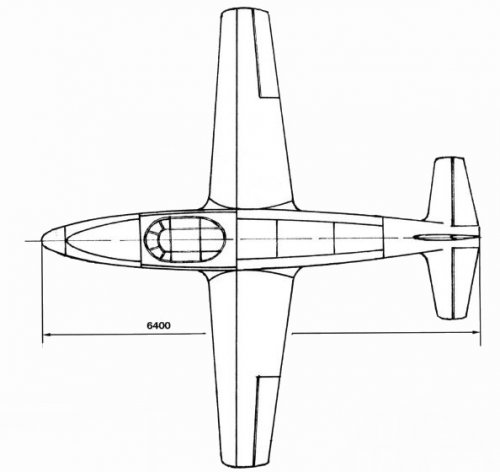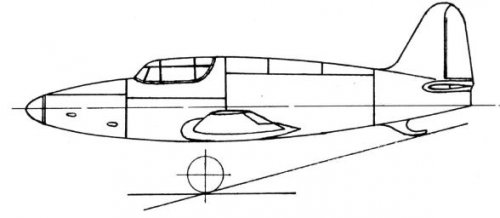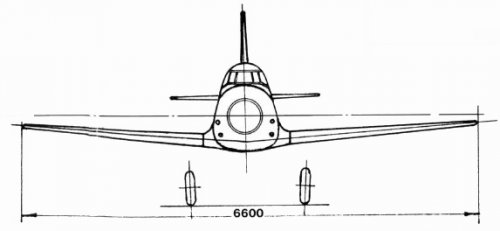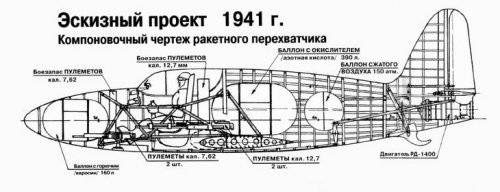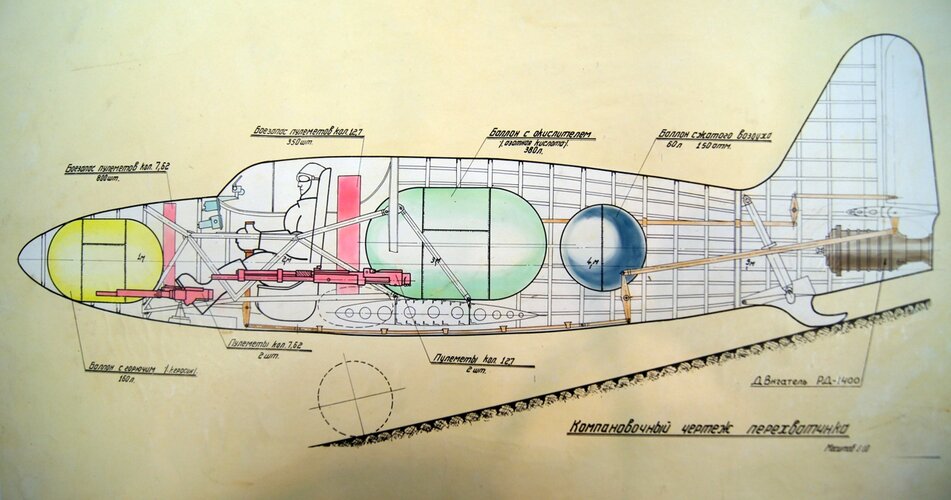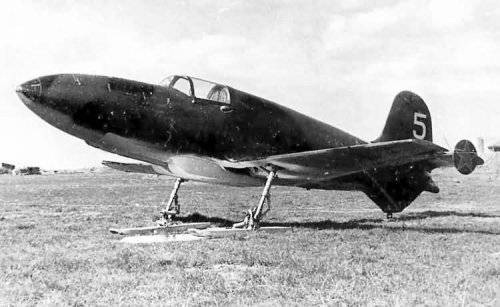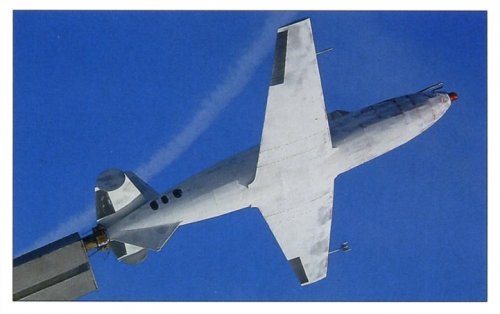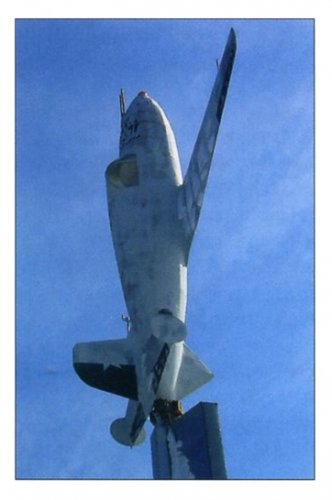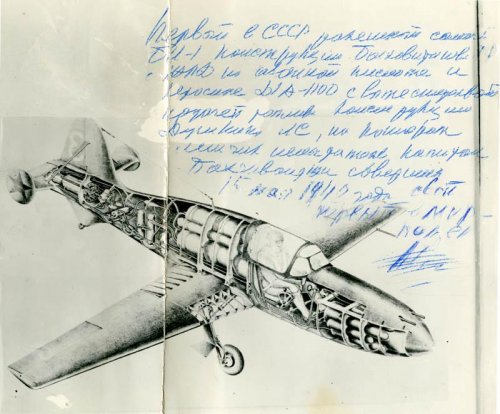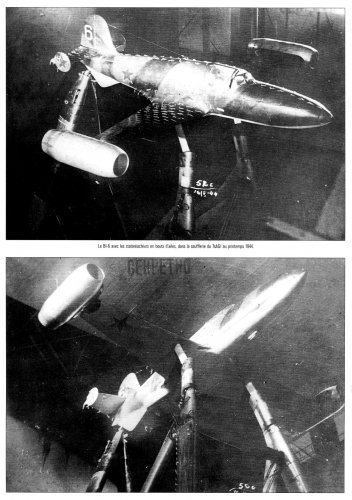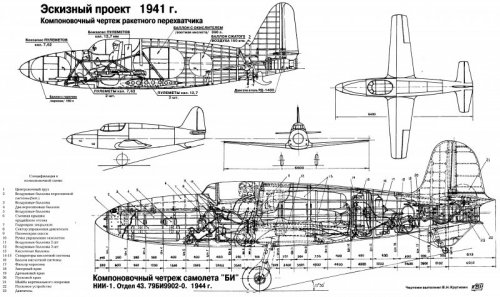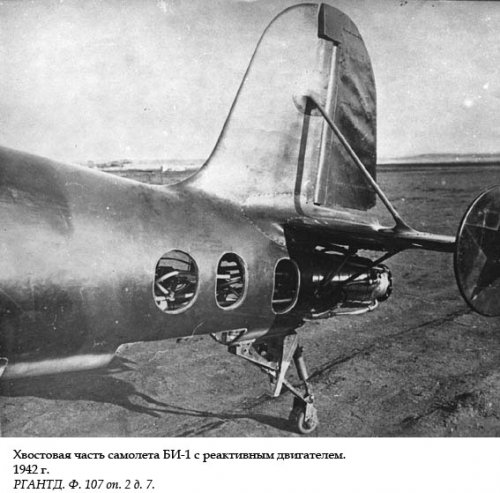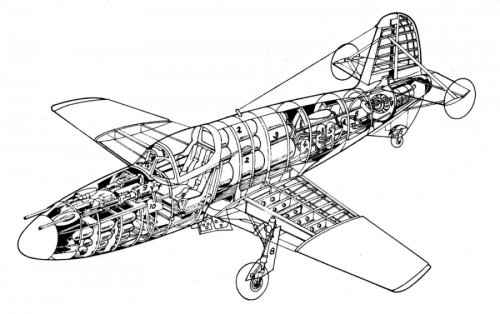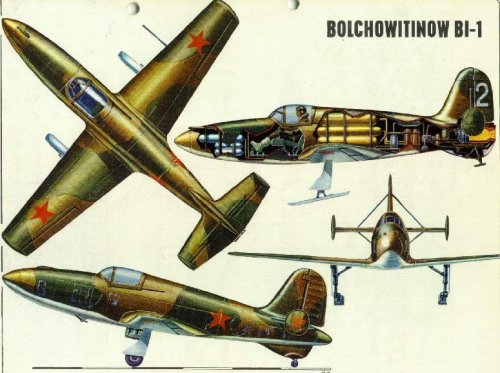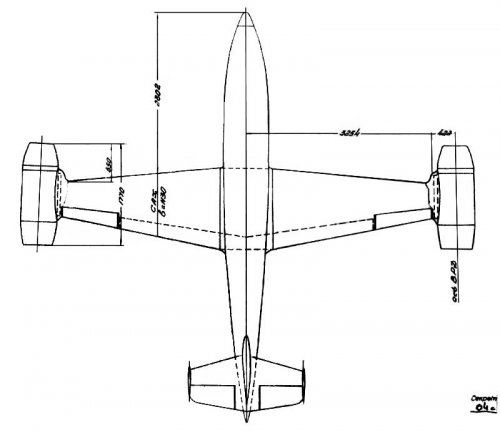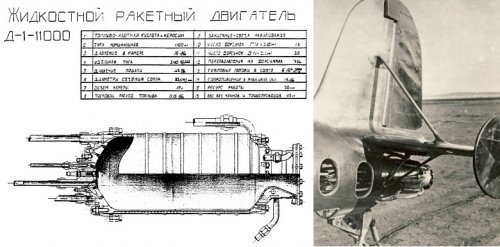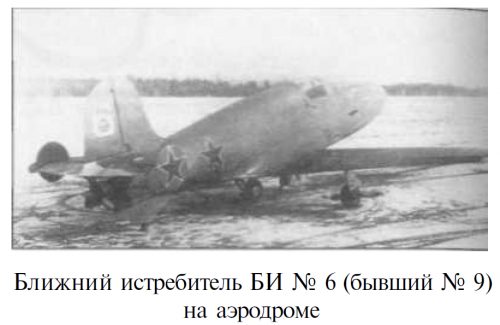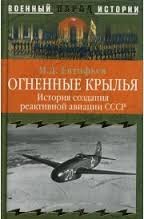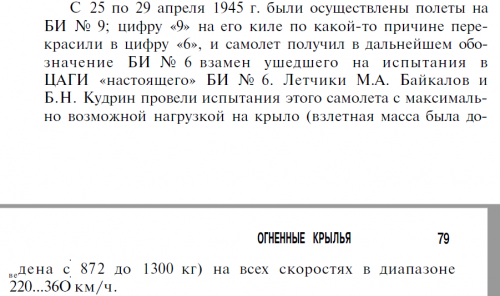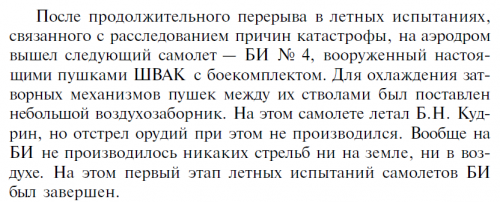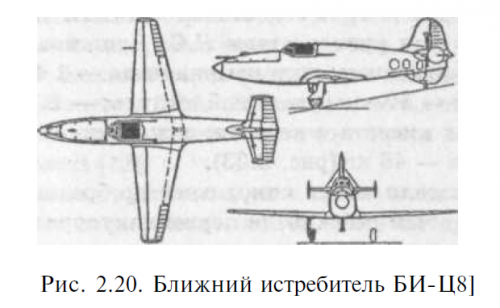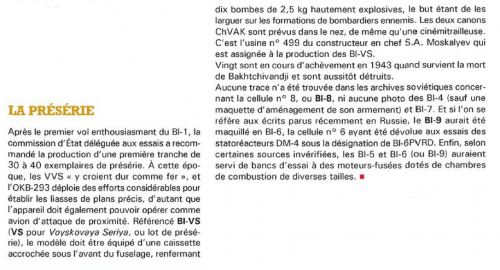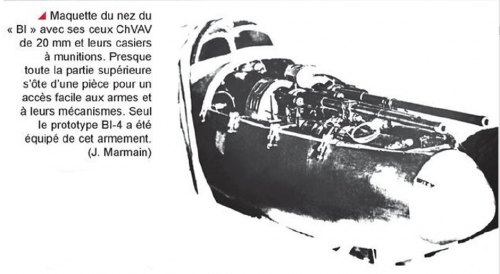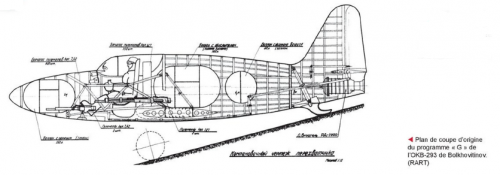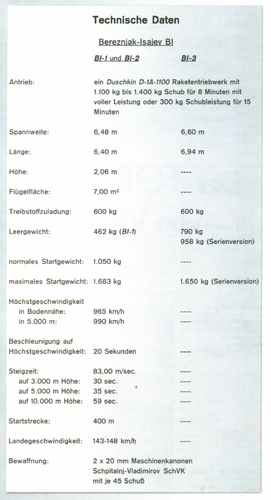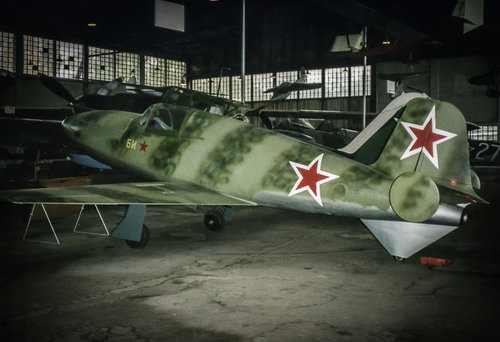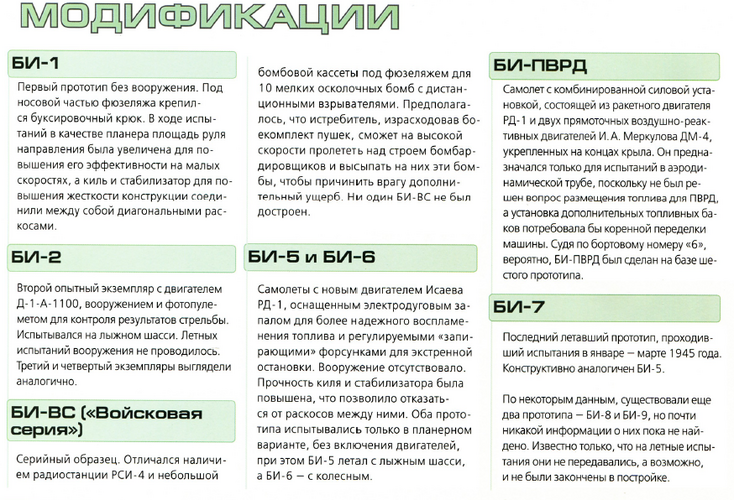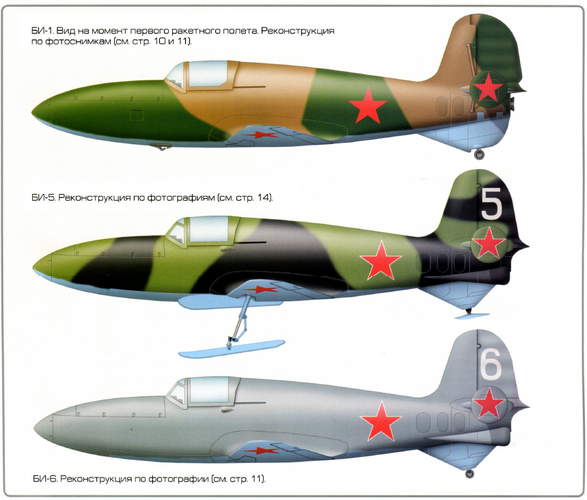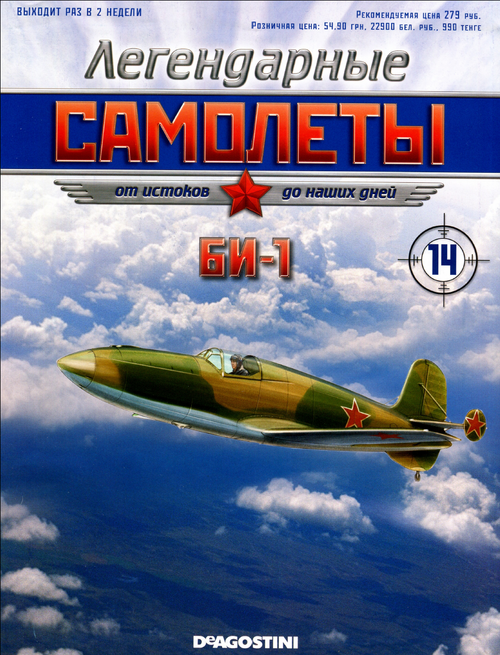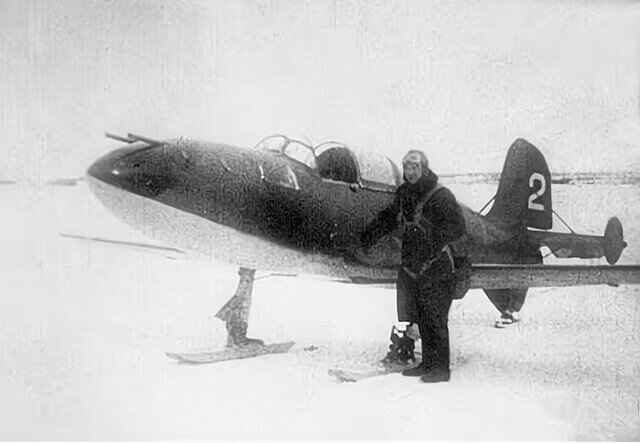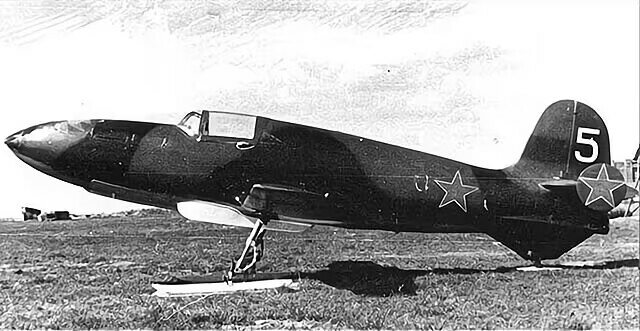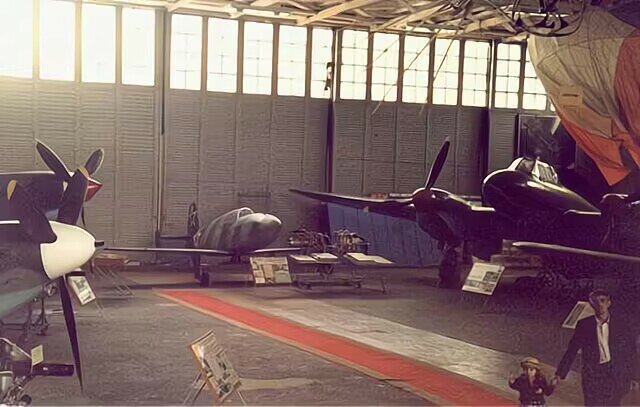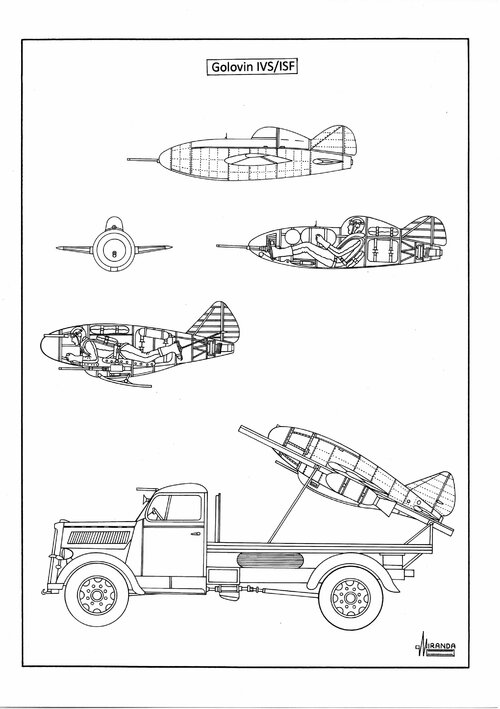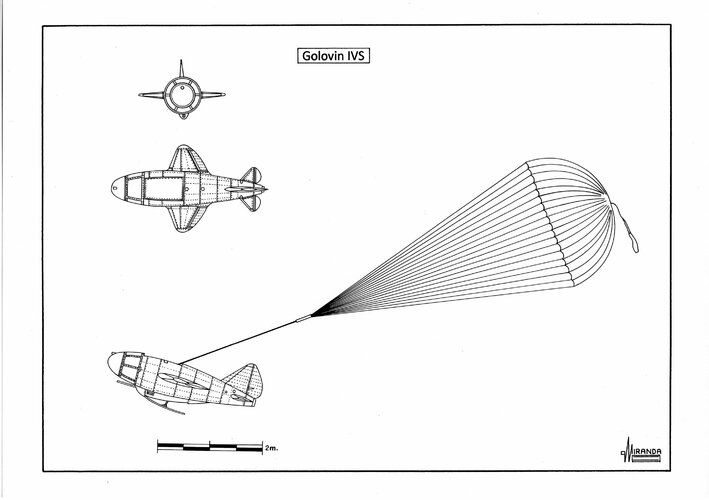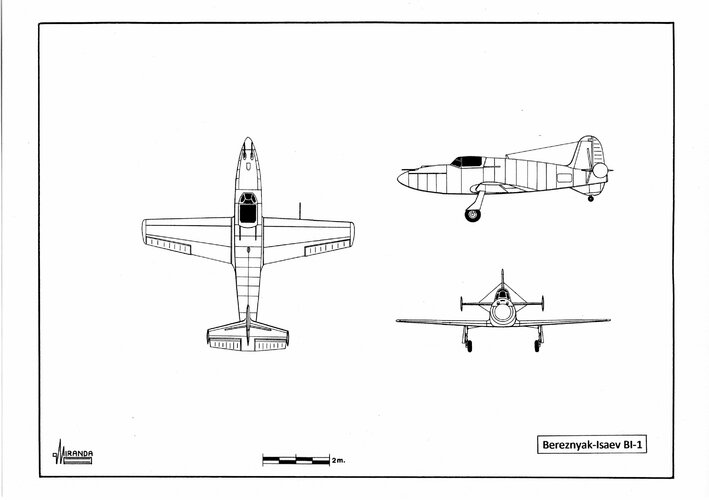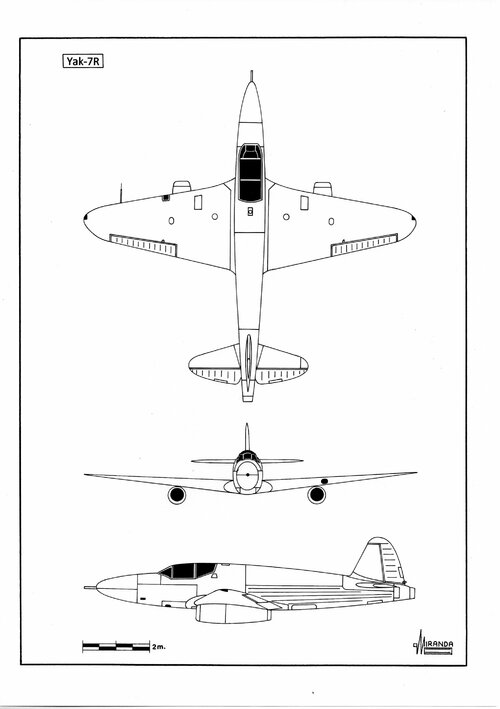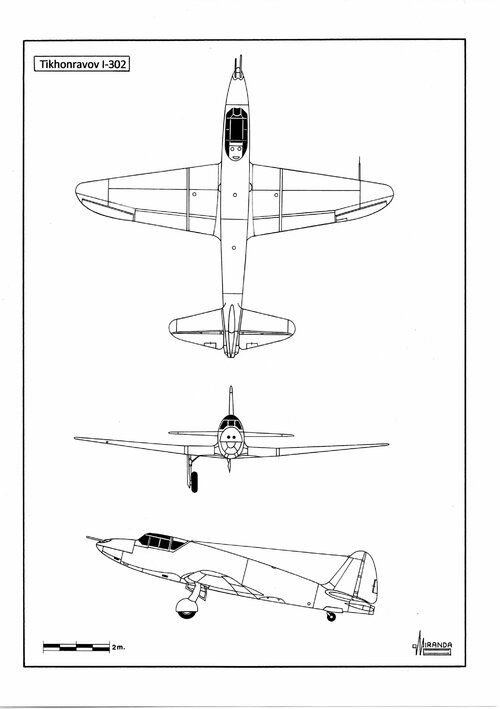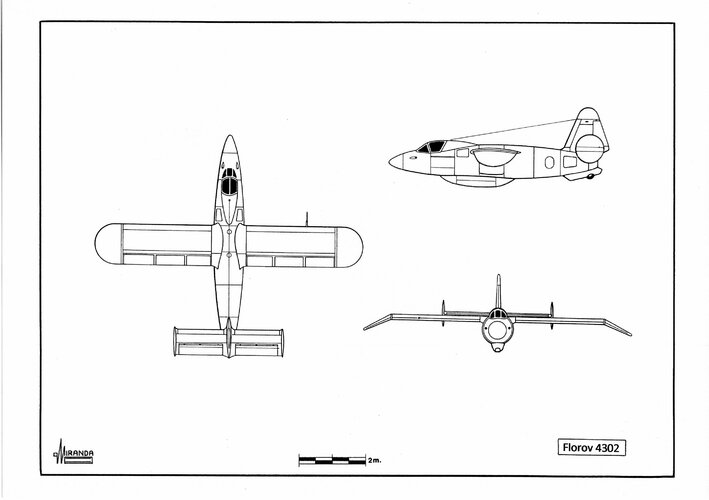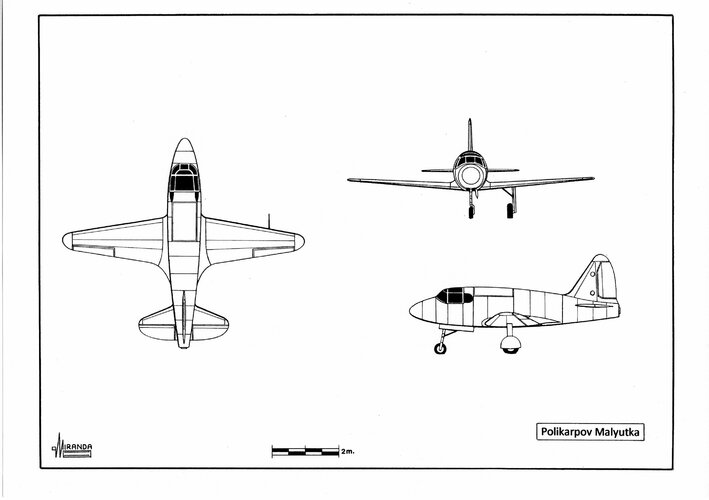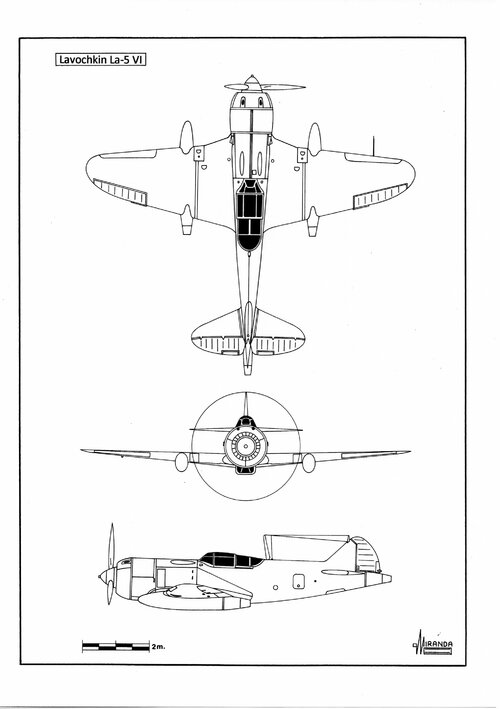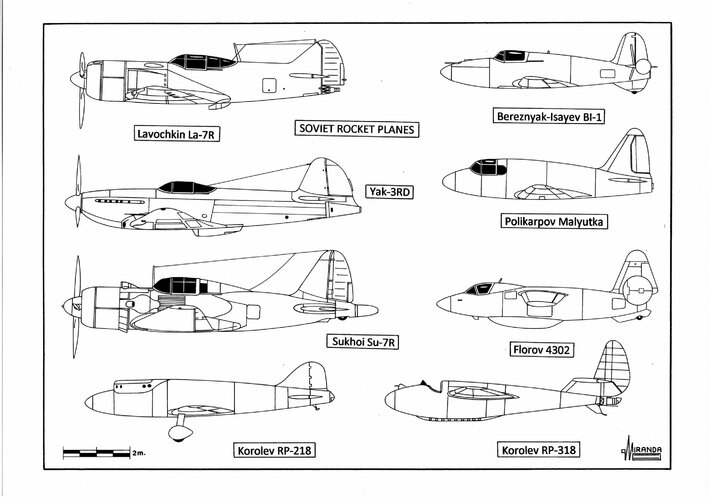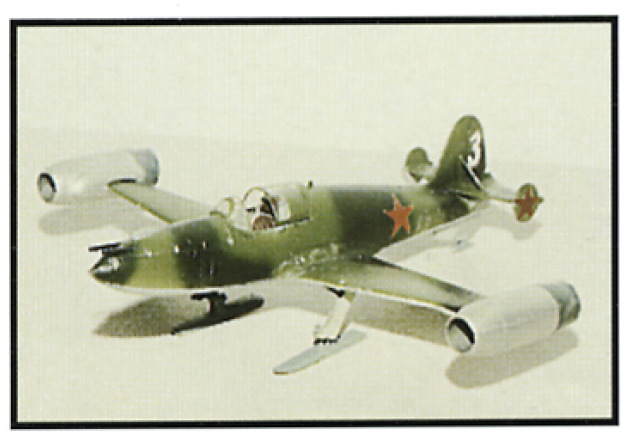You are using an out of date browser. It may not display this or other websites correctly.
You should upgrade or use an alternative browser.
You should upgrade or use an alternative browser.
Bereznyak-Isayev aircraft
- Thread starter hesham
- Start date
- Joined
- 7 June 2009
- Messages
- 525
- Reaction score
- 127
Mikhail Maslov doesn't mention BI-8. The BI-7 was the last built prototype - it made some flights in January 1945, piloted by Boris Kudrin.
The photo by dan_inbox represents BI-1, the first prototype, after it first and only flight on 15 May 1942.
The photo by dan_inbox represents BI-1, the first prototype, after it first and only flight on 15 May 1942.
- Joined
- 25 June 2009
- Messages
- 13,751
- Reaction score
- 2,943
Found two photos of a replica of the BI-1 (the Soviet Union's very first jet aircraft) as exhibited on a pole at Jekaterinburg airport.
However the images are oddly labeled as depicting a "Bolkhovitinov BI-1".
This is the second time I've seen the BI-1 associated with that engineer. Was there any involvement of Bolkhovitinov in the design, or is it just a mistake that keeps being repeated?
However the images are oddly labeled as depicting a "Bolkhovitinov BI-1".
This is the second time I've seen the BI-1 associated with that engineer. Was there any involvement of Bolkhovitinov in the design, or is it just a mistake that keeps being repeated?
Attachments
- Joined
- 7 June 2009
- Messages
- 525
- Reaction score
- 127
Hi Stephane!
Neither Alexander Bereznyak nor Alexei Isayev didn't have design bureau of their own. They both were employed in OKB-293 led by Bolkhovitinov. So, all the official documents depicted the BI as Bolkhovitinov design. Unfortunately I don't know how much was the involvement of Bolkhovitinov himself in the design (but, anyway, it could not be less than Messerschmitt involvement in "his" Me 163).
See for example http://rusarchives.ru/victory65/pages/14_10_1.htm (from Russian State Archive of scientific and technical documentation, stock No.133, batch No.1, document No.358, the personal stock of Leonid S. Dushkin). The note written on the cutaway picture says:
“The first in USSR rocketplane BI-1 designed by Bolkhovitinov V.F., with nitric acid/kerosene LRE D1A-1100 designed by Dushkin L.S., with displacing propellant supply system; the test pilot Captain Bakhchivandzhi made with it on May 15, 1942 his world first flight.”
By the way, there is no original BI-1 remaining. That one from Yekaterinburg is just a mockup, as well as the Monino one.
Neither Alexander Bereznyak nor Alexei Isayev didn't have design bureau of their own. They both were employed in OKB-293 led by Bolkhovitinov. So, all the official documents depicted the BI as Bolkhovitinov design. Unfortunately I don't know how much was the involvement of Bolkhovitinov himself in the design (but, anyway, it could not be less than Messerschmitt involvement in "his" Me 163).
See for example http://rusarchives.ru/victory65/pages/14_10_1.htm (from Russian State Archive of scientific and technical documentation, stock No.133, batch No.1, document No.358, the personal stock of Leonid S. Dushkin). The note written on the cutaway picture says:
“The first in USSR rocketplane BI-1 designed by Bolkhovitinov V.F., with nitric acid/kerosene LRE D1A-1100 designed by Dushkin L.S., with displacing propellant supply system; the test pilot Captain Bakhchivandzhi made with it on May 15, 1942 his world first flight.”
By the way, there is no original BI-1 remaining. That one from Yekaterinburg is just a mockup, as well as the Monino one.
Attachments
- Joined
- 25 June 2009
- Messages
- 13,751
- Reaction score
- 2,943
redstar72 said:Neither Alexander Bereznyak nor Alexei Isayev didn't have design bureau of their own. They both were employed in OKB-293 led by Bolkhovitinov. So, all the official documents depicted the BI as Bolkhovitinov design. Unfortunately I don't know how much was the involvement of Bolkhovitinov himself in the design (but, anyway, it could not be less than Messerschmitt involvement in "his" Me 163).
By the way, there is no original BI-1 remaining. That one from Yekaterinburg is just a mockup, as well as the Monino one.
Thanks a lot for clarifying things, redstar72!
blackkite
Don't laugh, don't cry, don't even curse, but.....
- Joined
- 31 May 2007
- Messages
- 8,286
- Reaction score
- 5,851
Rocket Fighter "B" Bereznyak-Isayev BI.
http://translate.google.fr/translate?hl=fr&sl=ru&tl=en&u=https%3A%2F%2Ftopwar.ru%2F26554-raketnyy-istrebitel-bi.html&sandbox=1
"To determine the increase of the combat capabilities of the samples - BI-6 - ram equipped, air-reakativnymi engines. Pryamotochki installed at the ends of the wings, in such a BI-6 was tested in the tunnel TsAGI in May 1944"
https://en.wikipedia.org/wiki/Bereznyak-Isayev_BI-1
http://www.airwar.ru/enc/fww2/bi1.html
http://www.panzercentral.com/forum/viewtopic.php?f=93&t=47386
"On May 15 the first flight of BI-1 was made, reaching an altitude of 840 meters and a maximum speed of 400 km/h. The second flight on Jan 10, 1943, reached 1100 meters but with the engine still throttled back for a maximum speed of 400 km/h. The third flight was made on Jan 12 (some sources say Feb 10) with the engine opened up to full thrust of 1100kgf and a speed of 675 km/h and a maximum altitude of 2190 meters were achieved. Later flights reached a maximum altitude of 4000 meters with a maximum rate of climb of 83 meters per second with a full load of ammunition. On March 27, during a low-altitude test flight, Backchivandzhi pushed the aircraft's speed to an estimated velocity of 990 km/h, but lost control due to the effects of transonic velocity and crashed. While development of the rocket plane continued, the BI-4 model was combined with the Kostikov 302 design, which was fitted with a pair of DM-4 ramjet engines for sustained flight, and was flown for the first time in August 1943. Designated as the BI-6, it was used as the template for the mass production of 30 aircraft in late 1943 and 50 aircraft in 1944. It was powered by a Dushkin-Isaev D1A-1100 Rocket Engine producing 1100kgf thrust for one minute (with 350 kg of propellant) and 2x Merkulov DM-4 Ramjets to maintain a speed over 800km/h for 30 minutes. Their only mission was to intercept high-speed, high-altitude Germany jet bombers and reconnaissance aircraft. Two 20mm ShVAK cannon were mounted in the nose and two more in the bottom of the forward fuselage, each with 100 rounds."
Rocket fighter with ski.
https://youtu.be/WSsdU3ELQLc
http://translate.google.fr/translate?hl=fr&sl=ru&tl=en&u=https%3A%2F%2Ftopwar.ru%2F26554-raketnyy-istrebitel-bi.html&sandbox=1
"To determine the increase of the combat capabilities of the samples - BI-6 - ram equipped, air-reakativnymi engines. Pryamotochki installed at the ends of the wings, in such a BI-6 was tested in the tunnel TsAGI in May 1944"
https://en.wikipedia.org/wiki/Bereznyak-Isayev_BI-1
http://www.airwar.ru/enc/fww2/bi1.html
http://www.panzercentral.com/forum/viewtopic.php?f=93&t=47386
"On May 15 the first flight of BI-1 was made, reaching an altitude of 840 meters and a maximum speed of 400 km/h. The second flight on Jan 10, 1943, reached 1100 meters but with the engine still throttled back for a maximum speed of 400 km/h. The third flight was made on Jan 12 (some sources say Feb 10) with the engine opened up to full thrust of 1100kgf and a speed of 675 km/h and a maximum altitude of 2190 meters were achieved. Later flights reached a maximum altitude of 4000 meters with a maximum rate of climb of 83 meters per second with a full load of ammunition. On March 27, during a low-altitude test flight, Backchivandzhi pushed the aircraft's speed to an estimated velocity of 990 km/h, but lost control due to the effects of transonic velocity and crashed. While development of the rocket plane continued, the BI-4 model was combined with the Kostikov 302 design, which was fitted with a pair of DM-4 ramjet engines for sustained flight, and was flown for the first time in August 1943. Designated as the BI-6, it was used as the template for the mass production of 30 aircraft in late 1943 and 50 aircraft in 1944. It was powered by a Dushkin-Isaev D1A-1100 Rocket Engine producing 1100kgf thrust for one minute (with 350 kg of propellant) and 2x Merkulov DM-4 Ramjets to maintain a speed over 800km/h for 30 minutes. Their only mission was to intercept high-speed, high-altitude Germany jet bombers and reconnaissance aircraft. Two 20mm ShVAK cannon were mounted in the nose and two more in the bottom of the forward fuselage, each with 100 rounds."
Rocket fighter with ski.
https://youtu.be/WSsdU3ELQLc
blackkite
Don't laugh, don't cry, don't even curse, but.....
- Joined
- 31 May 2007
- Messages
- 8,286
- Reaction score
- 5,851
Hi! Slide show.
https://www.aviationsmilitaires.net/v2/base/view/Model/1417.html
Engine picture.
http://forum.aviation-ancienne.fr/t5897-quelques-prototypes-sovietiques-meconnus
French site.
http://translate.google.fr/translate?hl=fr&sl=fr&tl=en&u=http%3A%2F%2Fxplanes.free.fr%2Fflorov%2Fafr-5.html
https://www.aviationsmilitaires.net/v2/base/view/Model/1417.html
Engine picture.
http://forum.aviation-ancienne.fr/t5897-quelques-prototypes-sovietiques-meconnus
French site.
http://translate.google.fr/translate?hl=fr&sl=fr&tl=en&u=http%3A%2F%2Fxplanes.free.fr%2Fflorov%2Fafr-5.html
Attachments
- Joined
- 26 May 2006
- Messages
- 32,648
- Reaction score
- 11,841
hesham said:In my files,
the BI-9 was made its flight on April 1945,can anyone confirm of this ?.
I remember the source;
here is a more info about BI-9,also a BI-4,BI-7 and BI-Ts or BI-8.
Attachments
Last edited:
- Joined
- 26 May 2006
- Messages
- 32,648
- Reaction score
- 11,841
nuuumannn
Cannae be ar*ed changing my personal text
- Joined
- 21 October 2011
- Messages
- 276
- Reaction score
- 526
- Joined
- 25 January 2020
- Messages
- 1,065
- Reaction score
- 1,482
I remember seeing a documentary with the BI-1 included in it, I'll try my best to find it.
- Joined
- 25 January 2020
- Messages
- 1,065
- Reaction score
- 1,482
Found this so far:
- Joined
- 25 January 2020
- Messages
- 1,065
- Reaction score
- 1,482
Found it:
Section about the BI-1 is at around 16:11, but I would recommend watching the whole documentary, as it is extremely interesting and documents many little known Soviet projects.
Section about the BI-1 is at around 16:11, but I would recommend watching the whole documentary, as it is extremely interesting and documents many little known Soviet projects.
Zizi6785
ACCESS: Secret
- Joined
- 20 December 2006
- Messages
- 356
- Reaction score
- 267
From which book?From a Russian book.
- Joined
- 26 May 2006
- Messages
- 32,648
- Reaction score
- 11,841
Here it's.From which book?
Attachments
Shangri-La
ACCESS: Restricted
- Joined
- 25 January 2023
- Messages
- 12
- Reaction score
- 35
The Soviets had been experimenting with bipropellants rockets since 1929. In 1935 the RNII research institute had developed the ORM-12a rocket engine, with 400 kg peak thrust, to use as a take-off booster of the Tupolev TB-1 bomber.
The RDA-1-150, capable of producing 150 kg peak thrust burning a mixture of kerosene and acid nitric, was tested on February 11, 1939.
The new engine was throttleable and it was decided to use it as a power plant for an SK-9 glider as flying testbed. The prototype, named Korolev RP-318-1, was flown on February 28, 1940, reaching 140 km/h and 2,900 m with 110 seconds engine running.
After learning about the performances of the high-altitude Junkers Ju 86 P-1 reconnaissance airplane, the GKO authorized the use of rocket engine propulsion system for high-performance fighters.
After the German attack, several designs for potential rocket interceptors eventually came to be created in the Soviet Union.
Undoubtedly the smallest fighter in the history, similar to the German Bachem Natter, a project was conceived by the military engineer Lev Golovin in 1941, based in the aerodynamic and rocket propulsion principles of Konstantin E. Tsiolkowski. It was designed in two versions:
The ‘IVS’ (Istrebitel Voyskovogo Soprovozhdeniya) version for the Soviet Air Force was designed for the target defense of factories, communication nodes, refineries and headquarters. The ‘IVS’ was launched from a 40-degree truck ramp with 8 m length, helped by two solid fuel rockets. The launching team was formed by the pilot, the mechanic, and the truck driver.
The ‘ISF’ (Istrebitel Soprovozhdeniya Flota), the naval version, was designed for the target defense of the naval bases and warships.
The mass production of the Golovin fighter was rejected in favor of the conventional antiaircraft artillery.
Technical data
Type: VTO rocket interceptor, structure and cladding: light alloy, landing gear: retractable skid and brake-parachute with 9.39 m of diameter, engine: one Dushkin/Glushko RD-1 bi-propellant rocket with 300 kg thrust and two RATO solid fuel rockets with 1,000 kg peak thrust each, propellant tanks were mounted to both sides of the pilot containing nitric acid and kerosene in a ratio of 2 to 1 (probably 70 lt. of acid and 30 lt. of kerosene, pressurizer: nitrogen, armament: one 20 mm ShVAK cannon, wingspan: 5.74 ft. (1.75 m), length: 9.48 ft. (3 m), height: 3.4 ft. (1.05 m), wing surface: 11 sq. ft. (1 sq. m), maximum weight: 662 lbs. (300 kg), estimated maximum speed: 659 mph (1,060 km/h), estimated climb rate: 820 ft./second, estimated ceiling: 24,600 ft. (7,500 m).
During ground test conducted in the spring of 1941, the Dushkin-Isayev D-1A-1100 acid/kerosene rocket motor produced 1,100 kg peak thrust.
To achieve that power, the engine used fuel pumps that suffered serious corrosion problems due to acid, which could not be solved. It was necessary to reuse the old pressurization system by compressed air, thus reducing the powered endurance to just 15 minutes.
In June 1941 it was decided to use the D-1A-1100 for the propulsion of a small point-defense interceptor designed by the engineers A.Ya Bereznyak and A.A. Isayev.
The prototype BI-1 was flown, in glider configuration, on September 10, 1941.
The rocket engine exploded during ground test on February 20, 1942, due to the fragility of the combustion chamber and the first powered flight was conducted by the second prototype BI-2 on May 15, 1942. During this first flight the engine only worked for just under a minute.
The BI airframe was not properly designed to high-speed flight. On March 27, 1943, the BI-3 prototype suffered compressibility buffeting and was destroyed because of an uncontrollable nose-down pitch at 497 mph (800 km/h).
All the work on the 50 pre-production machines was abandoned but some flight testing was continued with the BI-6 and BI-7 prototypes until 1945.
Bereznyak-Isayev BI technical data
Wingspan: 21.2 ft. (6.48 m), length: 21 ft. (6.4 m), height: 6.8 ft. (2.06 m), wing surface: 75.35 sq. ft. (7 sq. m), take-off weight: 3,710 lb (1,683 kg), estimated maximum speed: 559 mph (900 km/h).
In the Yak-7R modification, proposed in 1942, the M-105 piston engine was replaced by the pilot cockpit and the nose armament. One D-1A rocket motor was mounted in the rear fuselage and two Merkulov DM-4C ramjets were fitted under the wings, but the GKO did not authorize the project and the airframe conversion was never completed.
Yak-7R technical data
Wingspan: 32.8 ft. (10 m), length: 31.4 ft. (9.58 m), height: 7.4 ft. (2.26 m), wing surface: 190.5 sq. ft. (17.15 sq. m).
The loss of official interest in rocket interceptors also affected development of the Tikhonravov I-302, Florov 4302 and Polikarpov Malyutka projects.
The I-302 was flight-tested as a glider from August 1943, but the project was cancelled in March 1944 before the rocket engine was installed in the prototype. The Dushkin/Shtokolov RD-2-M-3V rocket had a main combustion chamber rated at 1,100 kg thrust and a cruise chamber rated at 450 kg thrust.
Two DM-4C ramjets fitted under the wings of the second prototype I-302 P had been planned.
Tikhonravov I-302 technical data
Wingspan: 37 ft. (11.4 m), length: 26.2 ft. (8 m), height: 7.7 ft. (2.36 m), wing surface: 198 sq. ft. (17.8 sq. m), take-off weight: 19,205 lb (8,700 kg), estimated maximum speed: 559 mph (900 km/h).
In 1943 a design team of the Air Force Research Institute (NIIVS), under the leadership of Ilya Florov, was tasked with developing an aerodynamic research rocket plane for testing high-speed wings and control systems.
In 1946, the first prototype, known as Aircraft 4302, was flight tested in glider configuration.
In August 1947, the second prototype was flown at 323 mph (520 km/h) powered by one RD-2M-3 rocket motor with two combustion chambers rated at 1,450 and 400 kg thrust.
The project was cancelled in favour of the MiG I-270.
Florov 4302-02 technical data
Wingspan: 22.7 ft. (6.93 m), length: 23.3 ft. (7.12 m), height: 7 ft. (2.12 m), take-off weight: 5,243 lb (2,398 kg), estimated maximum speed: 323 mph (520 km/h).
The Malyutka project had not yet reached the prototype stage when it was cancelled on July 30, 1944.
Malyutka technical data
Wingspan: 21 ft. (6.4 m), length: 20.7 ft. (6.3 m), height: 8.8 ft. (2.69 m), wing surface: 108 sq. ft. (10 sq. m), take-off weight: 5,622 lb (2,550 kg), estimated maximum speed: 544 mph (875 km/h).
Sergei Korolev proposed a rocket-boosted version of the Lavochkin La-5 standard under the La-5 VI (Visotnyi Istrebitel) codename.
The modification consisted on three Glushko RD-1 Khz bipropellant rocket motors, with electric ignition system, mounted under the wings and in the rear fuselage.
It was expected a top speed of 590 mph (950 km/h) and 55,760 ft. (17,000 m) ceiling but the Lavochkin design bureau estimated that the rocket fuel could react with wood causing fires and decided to use a La-7, with metallic structure.
The prototype La-7R was flight tested in October 1944, reaching 461 mph (742 km/h) powered by one M-82 reciprocating engine and one acid/kerosene rocket motor RD-1 KhZ with 300 kg peak thrust.
The second prototype attained 494 mph (795 km/h) and 42,640 ft. (13,000 m) ceiling powered by one ZhRD-1 rocket with hypergolic chemical ignition.
On May 12, 1945, the engine exploded during ground test destroying the prototype. Operation with the ZhRD-1 was found to be extremely hazardous, with explosions a common occurrence.
Flight testing continued until February 1945.
Lavochkin La-7R technical data
Wingspan: 32 ft. (9.8 m), length: 28.4 ft. (8.67 m), height: 2.54 ft. (2.7 m), wing surface: 189.3 sq. ft. (17.59 sq. m), take-off weight: 7,704 lb. (3,490 Kg).
A third prototype named La-120 R was flown in January 1945 reaching 500 mph (805 km/h) powered by one RD-1 CH2-X3 rocket.
The Yak-3 RD prototype was flight tested on December 22, 1944, powered by one VK-105 PF2 piston engine and one RD-1 KhZ
The rocket engine proved to be unreliable and was replaced by a ZhRD-1. The Yak-3R attained 486 mph (782 km/h) flying at 25,590 ft. (7,800 m).
Rocket malfunction continued. On May 14, 1945, there was an explosion during the ground tests.
On August 16, 1945, during a 510 mph (820 km/h) run at 8,200 ft (2,500 m) the prototype suddenly entered a steep dive and crashed.
Yakovlev Yak-3 RD technical data
Wingspan: 30 ft. (9.2 m), length: 29.6 ft. (9.02 m), height: 7.9 ft. (2.42 m), wing surface: 159.6 sq. ft. (14.83 sq. m), take-off weight: 7,616 lb. (3,450 Kg).
The RDA-1-150, capable of producing 150 kg peak thrust burning a mixture of kerosene and acid nitric, was tested on February 11, 1939.
The new engine was throttleable and it was decided to use it as a power plant for an SK-9 glider as flying testbed. The prototype, named Korolev RP-318-1, was flown on February 28, 1940, reaching 140 km/h and 2,900 m with 110 seconds engine running.
After learning about the performances of the high-altitude Junkers Ju 86 P-1 reconnaissance airplane, the GKO authorized the use of rocket engine propulsion system for high-performance fighters.
After the German attack, several designs for potential rocket interceptors eventually came to be created in the Soviet Union.
Undoubtedly the smallest fighter in the history, similar to the German Bachem Natter, a project was conceived by the military engineer Lev Golovin in 1941, based in the aerodynamic and rocket propulsion principles of Konstantin E. Tsiolkowski. It was designed in two versions:
The ‘IVS’ (Istrebitel Voyskovogo Soprovozhdeniya) version for the Soviet Air Force was designed for the target defense of factories, communication nodes, refineries and headquarters. The ‘IVS’ was launched from a 40-degree truck ramp with 8 m length, helped by two solid fuel rockets. The launching team was formed by the pilot, the mechanic, and the truck driver.
The ‘ISF’ (Istrebitel Soprovozhdeniya Flota), the naval version, was designed for the target defense of the naval bases and warships.
The mass production of the Golovin fighter was rejected in favor of the conventional antiaircraft artillery.
Technical data
Type: VTO rocket interceptor, structure and cladding: light alloy, landing gear: retractable skid and brake-parachute with 9.39 m of diameter, engine: one Dushkin/Glushko RD-1 bi-propellant rocket with 300 kg thrust and two RATO solid fuel rockets with 1,000 kg peak thrust each, propellant tanks were mounted to both sides of the pilot containing nitric acid and kerosene in a ratio of 2 to 1 (probably 70 lt. of acid and 30 lt. of kerosene, pressurizer: nitrogen, armament: one 20 mm ShVAK cannon, wingspan: 5.74 ft. (1.75 m), length: 9.48 ft. (3 m), height: 3.4 ft. (1.05 m), wing surface: 11 sq. ft. (1 sq. m), maximum weight: 662 lbs. (300 kg), estimated maximum speed: 659 mph (1,060 km/h), estimated climb rate: 820 ft./second, estimated ceiling: 24,600 ft. (7,500 m).
During ground test conducted in the spring of 1941, the Dushkin-Isayev D-1A-1100 acid/kerosene rocket motor produced 1,100 kg peak thrust.
To achieve that power, the engine used fuel pumps that suffered serious corrosion problems due to acid, which could not be solved. It was necessary to reuse the old pressurization system by compressed air, thus reducing the powered endurance to just 15 minutes.
In June 1941 it was decided to use the D-1A-1100 for the propulsion of a small point-defense interceptor designed by the engineers A.Ya Bereznyak and A.A. Isayev.
The prototype BI-1 was flown, in glider configuration, on September 10, 1941.
The rocket engine exploded during ground test on February 20, 1942, due to the fragility of the combustion chamber and the first powered flight was conducted by the second prototype BI-2 on May 15, 1942. During this first flight the engine only worked for just under a minute.
The BI airframe was not properly designed to high-speed flight. On March 27, 1943, the BI-3 prototype suffered compressibility buffeting and was destroyed because of an uncontrollable nose-down pitch at 497 mph (800 km/h).
All the work on the 50 pre-production machines was abandoned but some flight testing was continued with the BI-6 and BI-7 prototypes until 1945.
Bereznyak-Isayev BI technical data
Wingspan: 21.2 ft. (6.48 m), length: 21 ft. (6.4 m), height: 6.8 ft. (2.06 m), wing surface: 75.35 sq. ft. (7 sq. m), take-off weight: 3,710 lb (1,683 kg), estimated maximum speed: 559 mph (900 km/h).
In the Yak-7R modification, proposed in 1942, the M-105 piston engine was replaced by the pilot cockpit and the nose armament. One D-1A rocket motor was mounted in the rear fuselage and two Merkulov DM-4C ramjets were fitted under the wings, but the GKO did not authorize the project and the airframe conversion was never completed.
Yak-7R technical data
Wingspan: 32.8 ft. (10 m), length: 31.4 ft. (9.58 m), height: 7.4 ft. (2.26 m), wing surface: 190.5 sq. ft. (17.15 sq. m).
The loss of official interest in rocket interceptors also affected development of the Tikhonravov I-302, Florov 4302 and Polikarpov Malyutka projects.
The I-302 was flight-tested as a glider from August 1943, but the project was cancelled in March 1944 before the rocket engine was installed in the prototype. The Dushkin/Shtokolov RD-2-M-3V rocket had a main combustion chamber rated at 1,100 kg thrust and a cruise chamber rated at 450 kg thrust.
Two DM-4C ramjets fitted under the wings of the second prototype I-302 P had been planned.
Tikhonravov I-302 technical data
Wingspan: 37 ft. (11.4 m), length: 26.2 ft. (8 m), height: 7.7 ft. (2.36 m), wing surface: 198 sq. ft. (17.8 sq. m), take-off weight: 19,205 lb (8,700 kg), estimated maximum speed: 559 mph (900 km/h).
In 1943 a design team of the Air Force Research Institute (NIIVS), under the leadership of Ilya Florov, was tasked with developing an aerodynamic research rocket plane for testing high-speed wings and control systems.
In 1946, the first prototype, known as Aircraft 4302, was flight tested in glider configuration.
In August 1947, the second prototype was flown at 323 mph (520 km/h) powered by one RD-2M-3 rocket motor with two combustion chambers rated at 1,450 and 400 kg thrust.
The project was cancelled in favour of the MiG I-270.
Florov 4302-02 technical data
Wingspan: 22.7 ft. (6.93 m), length: 23.3 ft. (7.12 m), height: 7 ft. (2.12 m), take-off weight: 5,243 lb (2,398 kg), estimated maximum speed: 323 mph (520 km/h).
The Malyutka project had not yet reached the prototype stage when it was cancelled on July 30, 1944.
Malyutka technical data
Wingspan: 21 ft. (6.4 m), length: 20.7 ft. (6.3 m), height: 8.8 ft. (2.69 m), wing surface: 108 sq. ft. (10 sq. m), take-off weight: 5,622 lb (2,550 kg), estimated maximum speed: 544 mph (875 km/h).
Sergei Korolev proposed a rocket-boosted version of the Lavochkin La-5 standard under the La-5 VI (Visotnyi Istrebitel) codename.
The modification consisted on three Glushko RD-1 Khz bipropellant rocket motors, with electric ignition system, mounted under the wings and in the rear fuselage.
It was expected a top speed of 590 mph (950 km/h) and 55,760 ft. (17,000 m) ceiling but the Lavochkin design bureau estimated that the rocket fuel could react with wood causing fires and decided to use a La-7, with metallic structure.
The prototype La-7R was flight tested in October 1944, reaching 461 mph (742 km/h) powered by one M-82 reciprocating engine and one acid/kerosene rocket motor RD-1 KhZ with 300 kg peak thrust.
The second prototype attained 494 mph (795 km/h) and 42,640 ft. (13,000 m) ceiling powered by one ZhRD-1 rocket with hypergolic chemical ignition.
On May 12, 1945, the engine exploded during ground test destroying the prototype. Operation with the ZhRD-1 was found to be extremely hazardous, with explosions a common occurrence.
Flight testing continued until February 1945.
Lavochkin La-7R technical data
Wingspan: 32 ft. (9.8 m), length: 28.4 ft. (8.67 m), height: 2.54 ft. (2.7 m), wing surface: 189.3 sq. ft. (17.59 sq. m), take-off weight: 7,704 lb. (3,490 Kg).
A third prototype named La-120 R was flown in January 1945 reaching 500 mph (805 km/h) powered by one RD-1 CH2-X3 rocket.
The Yak-3 RD prototype was flight tested on December 22, 1944, powered by one VK-105 PF2 piston engine and one RD-1 KhZ
The rocket engine proved to be unreliable and was replaced by a ZhRD-1. The Yak-3R attained 486 mph (782 km/h) flying at 25,590 ft. (7,800 m).
Rocket malfunction continued. On May 14, 1945, there was an explosion during the ground tests.
On August 16, 1945, during a 510 mph (820 km/h) run at 8,200 ft (2,500 m) the prototype suddenly entered a steep dive and crashed.
Yakovlev Yak-3 RD technical data
Wingspan: 30 ft. (9.2 m), length: 29.6 ft. (9.02 m), height: 7.9 ft. (2.42 m), wing surface: 159.6 sq. ft. (14.83 sq. m), take-off weight: 7,616 lb. (3,450 Kg).
Attachments
Benito Del Rio
ACCESS: Restricted
- Joined
- 24 May 2023
- Messages
- 1
- Reaction score
- 1
Hi Vladimir....
Good day.
I want to as you for a High definition PDF of this line drawings, can it be possible? Will be so usefull because I'm begining a 3dmodel higly detailed of this particular rocket plane, would you help me? Please.
Yours!
Benito Del Rio
From Mexico city
Benito Del Rio
From Mexico city
Similar threads
-
New Fonthill Book - Rocket Interceptors 1941-1947
- Started by Justo Miranda
- Replies: 0
-
-
-
-

